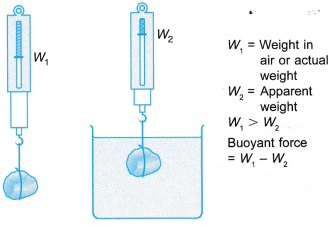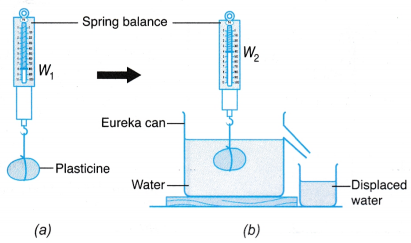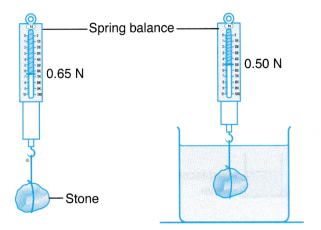How Do You Find Buoyant Force
Buoyancy
When a body is immersed in a liquid, the liquid exerts an upward force on the body called as the ‘upthrust‘ or ‘buoyant force.’
Factors affecting upthrust:
1. Larger the volume of the body submerged in the liquid, greater is the upthrust.
2. Larger the density of the liquid, greater is the upthrust.
Applying Archimedes’ Principle
Figure shows a boy transferring a boulder from the seabed to a beach.

(a) He finds that the boulder becomes heavier as it emerges from the surface of the sea.
(b) The boulder is lighter when it is immersed in the sea because of the existence of the buoyant force.
(c) The buoyant force is an upward force resulting from an object being wholly or partially immersed in a fluid.
(d) The bigger the volume of the boulder immersed in the sea, the bigger the buoyant force.
 Figure shows the relationship between real weight and apparent weight of an object and the upward buoyant force acting on it.
Figure shows the relationship between real weight and apparent weight of an object and the upward buoyant force acting on it.
Buoyant force = Actual weight – Apparent weight
Therefore,
Apparent weight = Actual weight – Buoyant force
Experiment:
Aim: To investigate the relationship between the weight of water displaced and the buoyant force.
Situation: A hawker immersed a watermelon into a tub filled with water. Water was displaced from the tub when the watermelon was submerged in it. He noticed that the submerged watermelon was lighter.
 Problem: What is the relationship between the weight of water displaced and the buoyant force?
Problem: What is the relationship between the weight of water displaced and the buoyant force?
Materials: Plasticine, thread
Apparatus: Spring balance, electronic balance, eureka can, beaker
Method:

- The mass of an empty beaker, m, is measured with an electronic balance and recorded.
- A plasticine is attached to a spring balance with a string as shown in Figure (a).
- The weight of the plasticine, W1 is measured and recorded.
- Water is poured into a eureka can until it flows out of the spout of the can.
- When the water has stopped dripping from the spout, the empty beaker is placed under it.
- The plasticine is slowly lowered into the eureka can as shown in Figure (b) until it is completely immersed in the water.
- The readings of the spring balance, W2 and the mass of the beaker that is filled with displaced water, m2 are taken and recorded.
Results:

Discussion:
From the experiment, it is found that (m2 – m1) g = (W1 – W2).
Hence, the weight of water displaced is equal to the buoyant force.
Buoyant Force Example Problems with Solutions
Example 1. A body weighs 300 gmf in air and 260 gmf when completely immersed in water. Calculate the following
(i) loss in weight of the body
(ii) upthrust on the body.
Solution: Given: Weight of body in air = 300 gmf
Weight of the body in water = 260 gmf
∴ Loss in weight of the body = 300 – 260 = 40 gmf
∴ Upthrust of the body = Loss in weight
= 40 gmf
Example 2. A solid block of volume 2 litres has a weight of 80 N. What will be its weight when immersed completely in water ?
Solution: In order to calculate the weight of the block in water, first calculate the upthrust, i.e. the loss in weight of the body in water, then
Volume of the block = 2 litres = 2000 cc
∴ Volume of water displaced = 2000 cc
Weight of water displaced = 2000 gm
= 2.0 kgf
( Density of water = 1 gm/cc)
= 2.0 × 9.8 N = 19.6 N
∴ Upthrust of water = 19.6 N
Hence, weight of the body fully immersed in water = 80 N – 19.6 N = 60.4 N
Example 3. A solid block of density D has a weight W in air is fully immersed in a liquid of density d. Calculate its apparent weight when fully immersed in liquid.
Solution: Weight of the block = W
Density of block = D
∴ Volume of the block = \(\frac { W }{ D }\) . d
∴ Upthrust on the block = \(\frac { W }{ D }\) .d
∴ Loss in weight of the block inside liquid = \(\frac { W }{ D }\) .d
Hence, apparent weight of the block when fully immersed in water
\(=\text{W}-\frac{\text{W}}{\text{D}}\text{d}=\text{W}\left( 1-\frac{\text{d}}{\text{D}} \right)\)
Example 4. The weight of a stone in air is 0.65 N. When it is completely submerged in water, its weight is 0.50 N.
 What is the buoyant force acting on the stone when it is completely submerged in water?
What is the buoyant force acting on the stone when it is completely submerged in water?
Solution:
Buoyant force
= Actual weight – Apparent weight = 0.65 – 0.50 = 0.15 N
Example 5. Figure shows an empty oil drum floating on the surface of a pond.

Draw and label the two forces acting on the oil drum.
Solution:

